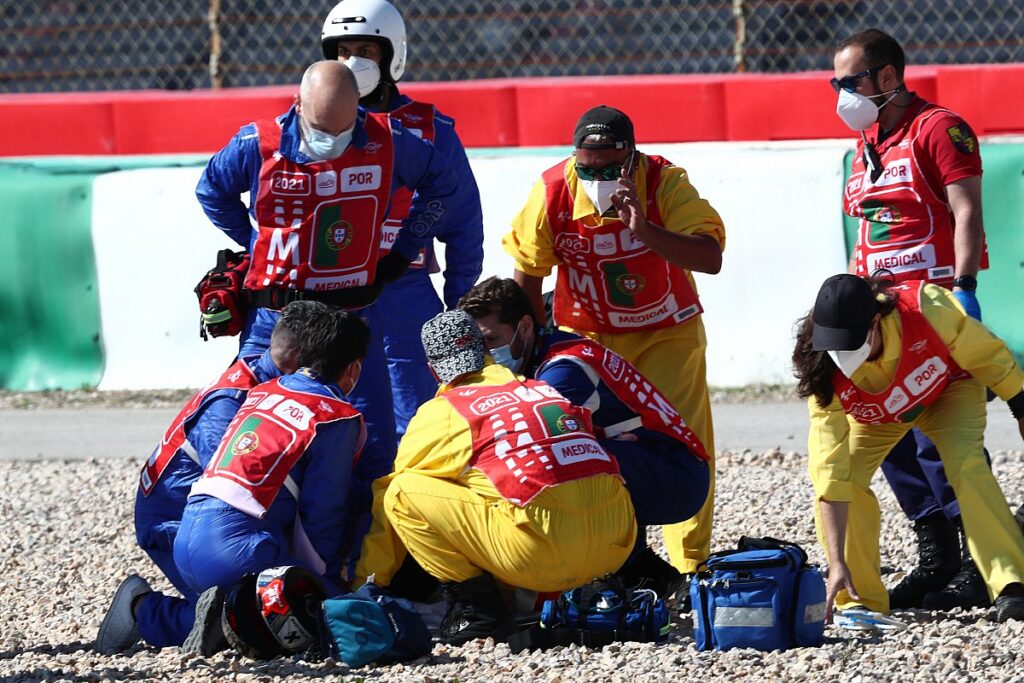
The Controversy Behind Jorge Martin’s Pre-Season Crash in MotoGP: A Deep Dive
Motorcycle racing is often a blend of speed, skill, and sometimes, danger. Fans all over the world are captivated by the adrenaline-pumping excitement of the MotoGP races. However, as thrilling as it is to watch, the sport also has its serious side, especially when something goes wrong. A recent incident involving Spanish racer Jorge Martin has brought safety concerns to the forefront and sparked intense discussions among teams, riders, and fans alike.
What Happened?
During a pre-season testing session at the Sepang International Circuit in Malaysia, Jorge Martin experienced a dramatic crash that left many in the MotoGP community deeply concerned. The crash, described as an “off-throttle highside,” means that Martin lost control of his bike when he wasn’t accelerating. This type of crash can be particularly dangerous because it happens when the rider is not actively pushing the bike’s limits. In this case, Martin suffered significant injuries, including broken bones in his hand and foot and a blow to the head.
You might be wondering why a crash like this could cause such a stir. Well, it’s all about accountability and safety in the fast-paced world of motorcycle racing. Martin’s crash not only affected him personally—requiring hospitalization and setting him back in his training—but also raised serious questions about the conditions and equipment used in the sport.
The Aftermath: Reactions and Concerns
After the incident, Massimo Rivola, the team principal of Aprilia Racing, stepped into the spotlight. He expressed his frustration and called for a thorough investigation into the cause of the crash. Rivola emphasized that the crash is not simply a case of rider error or a malfunctioning bike. Instead, he pointed fingers at the tire situation. Tires in MotoGP are not just rubber wheels; they play a critical role in bike performance and rider safety.
Michelin, the official tire supplier for MotoGP, found itself in a tough position. After all, tires are crucial for grip and control, especially when cornering at high speeds or during sudden changes in bike dynamics. Michelin representatives defended their product, asserting that the tires used during the testing period were normal and had been carefully monitored during transport and storage. They argued that this particular set of tires was consistent with what riders had used in past tests without major issues.
However, skepticism lingered. Teams began questioning whether the tires were truly suited for the conditions at Sepang, where temperatures can reach scorching highs. The allocation of softer tires—designed to provide better grip but at the risk of quicker wear—also came under scrutiny. Rivola highlighted these points as critical issues that needed addressing, arguing that safety cannot be compromised, especially when lives are at stake.
The Impact on MotoGP
Jorge Martin’s crash and the ensuing controversy didn’t just affect him; they sent ripples throughout the MotoGP paddock. Riders, mechanics, and team bosses began engaging in serious conversations about tire safety and reliability. With the new season on the horizon, everyone from rookies to seasoned veterans was left to wonder: Are the tires safe enough to handle the intense speed and conditions of MotoGP racing?
This situation also opens up broader discussions about the expectations placed on riders. Consider this: riders like Martin commit their lives to this sport. They push themselves and their machines to the absolute limit, facing not just the thrill of victory, but also the very real risk of injury or worse—especially in a sport like motorcycle racing, where one wrong move can lead to dire consequences. It’s essential that every aspect of the sport, including safety measures regarding equipment like tires, be meticulously managed.
Bridging the Gap: Riders and Manufacturers
As the MotoGP community discusses the implications of Martin’s crash, a significant focus lies on communication between riders and tire manufacturers. It’s crucial for manufacturers like Michelin to receive detailed feedback from riders about their experiences with tire performance. Riders can provide insights on how tires behave in various conditions, what changes they would like to see, and where they feel improvements are necessary.
Additionally, tire companies should consider collaborating more with teams and professional racers to ensure comprehensive testing under various conditions. By doing so, they could better anticipate potential tire-related issues and improve safety. Remember, effective communication can be the difference between a successful racing season and a tragic accident.
Looking Forward: A Call to Action
As MotoGP gears up for the upcoming season, the focus must remain on safety for all involved—riders, teams, and fans alike. The MotoGP organization has an undeniable responsibility to ensure that stringent safety regulations are enforced. They need to take Martin’s crash as a catalyst for change, pushing for transparency and reliability in tire performance and other critical safety measures.
For fans of motorcycle racing, all of this brings up an essential question: How can we, as passionate supporters of the sport, contribute to discussions surrounding safety and accountability? We all love the thrill of watching our favorite riders speed around the track, but we must also advocate for their safety and well-being.
Closing Thoughts
Jorge Martin’s crash during the pre-season testing has opened a Pandora’s box of issues primarily centered on safety in MotoGP. It serves as a reminder to everyone involved—riders, teams, manufacturers, and fans—that while speed and skill are crucial to the sport, safety cannot be an afterthought.
As we await the thrilling races that the MotoGP season promises, let’s reflect on how we can better support the sport, focusing on both excitement and safety. What do you think should be done to improve rider safety in MotoGP? Feel free to share your thoughts and engage in the conversation in the comments below!




